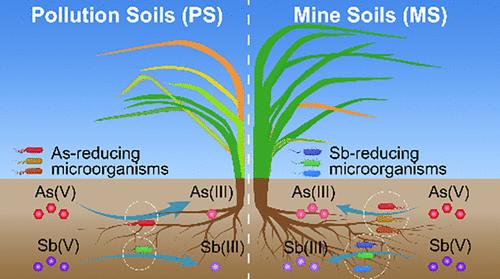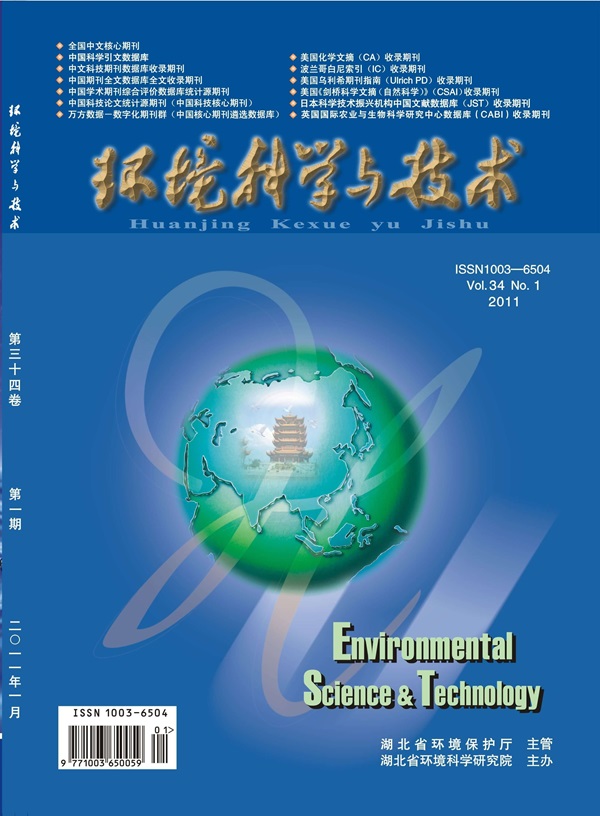植物根系相关生境中砷和锑还原微生物的代际特异性招募,以适应金属类金属污染
IF 10.8
1区 环境科学与生态学
Q1 ENGINEERING, ENVIRONMENTAL
引用次数: 0
摘要
植物招募微生物可提高其对环境胁迫的适应能力,但人们对根系相关壁龛如何招募特定微生物以适应金属类金属污染还不甚了解。本研究调查了在砷(As)和锑(Sb)胁迫下,紫根草(Vetiveria zizanioides)不同根系壁龛中微生物的世代招募情况。在受控条件下,在受砷和锑污染的矿山土壤(MS)和人工污染土壤(PS)中培养了两代紫茎蕨(Vetiveria zizanioides)。通过 16S rRNA、arsC 和 aioA 基因扩增片段和元基因组测序分析了根相关微生物群落。在第二代中,V. zizanioides 在 MS 中的内圈积累了较高的 As(III) 和 Sb(III) ,而其在 MS 中的生理指标优于在 PS 中观察到的指标。SourceTracker 分析显示,MS 中的 V. zizanioides 将还原 As(V) 和 Sb(V) 的微生物(如 Sphingomonales 和 Rhodospirillaceae)引入根瘤和内球。元基因组学分析进一步证实,这些被招募的微生物携带编码砷酸盐还原酶的基因,具有多种碳水化合物降解能力,富集于根瘤和内球,表明它们具有还原 As(V) 和 Sb(V) 以及分解根渗出物(如木聚糖和淀粉)的潜力。这些研究结果表明,V. zizanioides 在世代生长过程中会选择性地招募还原砷和锑的微生物,以减轻砷-锑的共污染,从而为加强对金属类金属污染物的植物修复提供了新的策略。本文章由计算机程序翻译,如有差异,请以英文原文为准。

Generational Specific Recruitment of Arsenic- and Antimony-Reducing Microorganisms in Plant Root-Associated Niches for Adapting to Metalloid-Metal Pollution
The recruitment of microorganisms by plants can enhance their adaptability to environmental stressors, but how root-associated niches recruit specific microorganisms for adapting to metalloid-metal contamination is not well-understood. This study investigated the generational recruitment of microorganisms in different root niches of Vetiveria zizanioides (V. zizanioides) under arsenic (As) and antimony (Sb) stress. The V. zizanioides was cultivated in As- and Sb-cocontaminated mine soils (MS) and artificial pollution soils (PS) over two generations in controlled conditions. The root-associated microbial communities were analyzed through 16S rRNA, arsC, and aioA gene amplicon and metagenomics sequencing. V. zizanioides accumulated higher As(III) and Sb(III) in its endosphere in MS in the second generation, while its physiological indices in MS were better than those observed in PS. SourceTracker analysis revealed that V. zizanioides in MS recruited As(V)- and Sb(V)-reducing microorganisms (e.g., Sphingomonales and Rhodospirillaceae) into the rhizoplane and endosphere. Metagenomics analysis further confirmed that these recruited microorganisms carrying genes encoding arsenate reductases with diverse carbohydrate degradation abilities were enriched in the rhizoplane and endosphere, suggesting their potential to reduce As(V) and Sb(V) and to decompose root exudates (e.g., xylan and starch). These findings reveal that V. zizanioides selectively recruits As- and Sb-reducing microorganisms to mitigate As–Sb cocontamination during the generational growth, providing insights into novel strategies for enhancing phytoremediation of metalloid-metal contaminants.
求助全文
通过发布文献求助,成功后即可免费获取论文全文。
去求助
来源期刊

环境科学与技术
环境科学-工程:环境
CiteScore
17.50
自引率
9.60%
发文量
12359
审稿时长
2.8 months
期刊介绍:
Environmental Science & Technology (ES&T) is a co-sponsored academic and technical magazine by the Hubei Provincial Environmental Protection Bureau and the Hubei Provincial Academy of Environmental Sciences.
Environmental Science & Technology (ES&T) holds the status of Chinese core journals, scientific papers source journals of China, Chinese Science Citation Database source journals, and Chinese Academic Journal Comprehensive Evaluation Database source journals. This publication focuses on the academic field of environmental protection, featuring articles related to environmental protection and technical advancements.
 求助内容:
求助内容: 应助结果提醒方式:
应助结果提醒方式:


